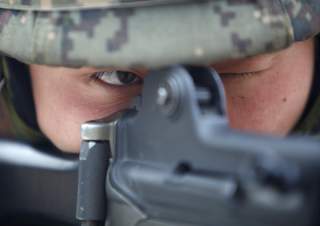This Assault Rifle Might Be the Deadliest Weapon Coming out of Korea (Not a Nuke)
But a pretty powerful rifle.
In the early 2000s, S&T Motiv (formerly Daewoo) began upgrading the weapon an eye towards integrating many accessories that began appearing on U.S. and NATO rifles. Attempts to refit many of the rifles with scope mounts were foiled by the age and condition of the weapons, and a number of new K2A rifles with flat-top receivers equipped with Picatinny rails were procured. These rifles are fitted with indigenously produced 1x red dot sights and are further capable of adding laser pointers and pistol fore grips, making the weapon as modifiable as contemporary Western rifles.
In the late twentieth century, one of the hallmarks of a modern military was a country’s ability to design and manufacture its own rifles. South Korea, an emerging military power, took that to heart and produced the K2 assault rifle. A blend of good ideas borrowed from other rifles, the K2 has served Republic of Korea forces for 35 years and with a raft of upgrades will serve for years more to come.
(This first appeared last year.)
After the Korean War, the Republic of Korea (ROK) armed forces were primarily supplied with surplus U.S. small arms. M1 Garands and M2 carbines armed the country’s large conscript army, though the former were ill-suited for Korean troops. The Daewoo corporation licensed the M16A1 design from Colt, but upon the license’s expiration, the Korean military would be left without a rifle to produce. Seoul decided it would design and manufacture its own rifle, to Korean specifications.
(Editor's Note: Looking for more perspectives on North Korea? Check out 27 expert predictions on North Korea for 2019 here.)
South Korean small arms engineers basically took the operating system behind Eugene Stoner’s AR-18 assault rifle and copied it. The AR-18, known as Stoner’s other assault rifle design (other than the AR-15), used a short-stroke gas piston and rotating bolt. The South Korean rifle design used a long stroke gas piston design and a gas system copied from the FN FAL battle rifle, with a three position gas regulator. At 7.2 pounds the rifle was about the same weight as other NATO 5.56-millimeter rifles.
The new rifle was a selective fire, fully automatic weapon capable of a maximum rate of fire of 750 rounds per minute. The weapon can be fired in single shot, three round burst, and fully automatic modes. The weapon had a 18.3-inch barrel length, was chambered in 5.56-millimeter, and accepted NATO standard STANAG 30 round magazines. Maximum effective range was the 400 meters, typical for 5.56-millimeter rifles with intermediate barrel lengths.
The rifle was named K2 and adopted for service in 1984. It was made entirely of stamped metal, machined, and plastic parts, and has a well-deserved reputation for sturdiness. The rifle was produced in the hundreds of thousands and assigned to nearly all ROK troops, although for many years reservists continued to use surplus American weapons and older M16A1s. The K2 also used iron sights well after many armies converted to optical sights.
In the early 2000s, S&T Motiv (formerly Daewoo) began upgrading the weapon an eye towards integrating many accessories that began appearing on U.S. and NATO rifles. Attempts to refit many of the rifles with scope mounts were foiled by the age and condition of the weapons, and a number of new K2A rifles with flat-top receivers equipped with Picatinny rails were procured. These rifles are fitted with indigenously produced 1x red dot sights and are further capable of adding laser pointers and pistol fore grips, making the weapon as modifiable as contemporary Western rifles.
In the early 2009s, the U.S. Army pursued a new infantry weapon, the Objective Individual Combat Weapon (OICW). OICW was to be a hybrid rifle pairing a conventional 5.56-millimeter assault rifle system with a 20-millimeter grenade launcher. This prompted South Korea to develop its own weapon in parallel, and the result was the K-11 rifle. The K-11 is basically a K-2 rifle mated to a 25-millimeter grenade launcher. The K-11 is equipped with an armored sight above the receiver that incorporates a ballistic computer, laser sight, and electronic grenade programmer. This allows the K-11 gunner to adjust the grenade fuze, giving it the ability to explode behind enemy cover. While the OICW was eventually canceled, the K-11 is now issued to Republic of Korea infantry, greatly increasing their firepower.
The manufacture of a country’s own small arms is no longer a strong benchmark of military power: France is importing new German rifles for the French Army and it seems likely the UK will adopt a foreign assault rifle post-2030. But the design and adoption of the K2 was a major milestone for South Korea. Although somewhat dated, the weapon is fundamentally sound and there is still plenty of room for growth in the K2 platform. Given Seoul’s industrial capacity—and export-oriented outlook—it’s not likely to adopt a foreign weapon any time soon.
Kyle Mizokami is a writer based in San Francisco who has appeared in The Diplomat, Foreign Policy, War is Boring and The Daily Beast. In 2009 he co-founded the defense and security blog Japan Security Watch.

